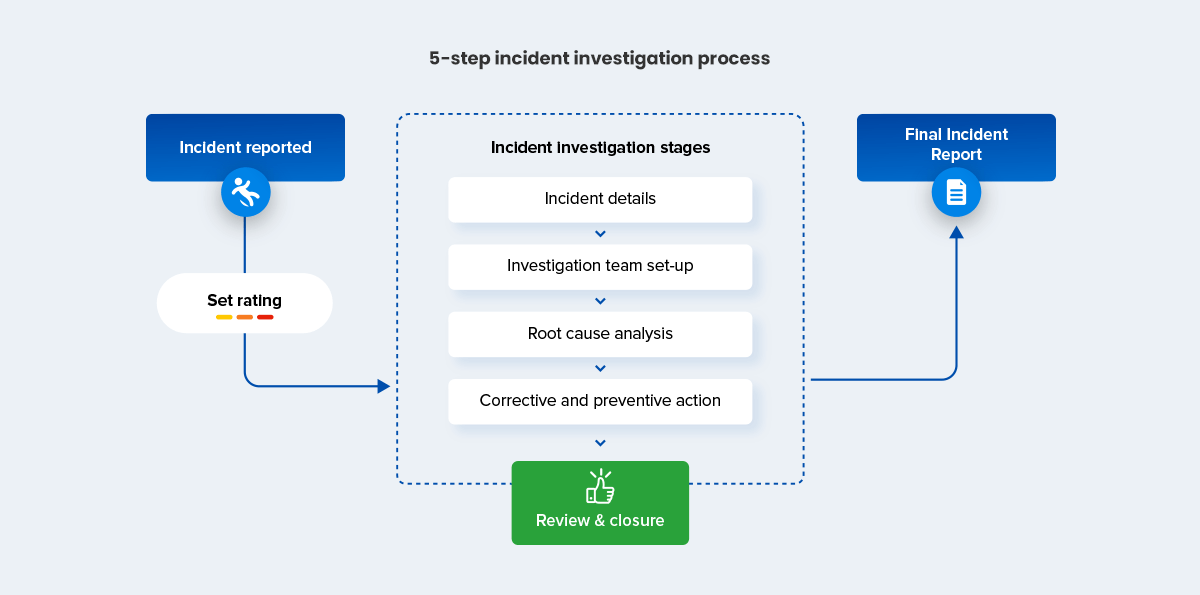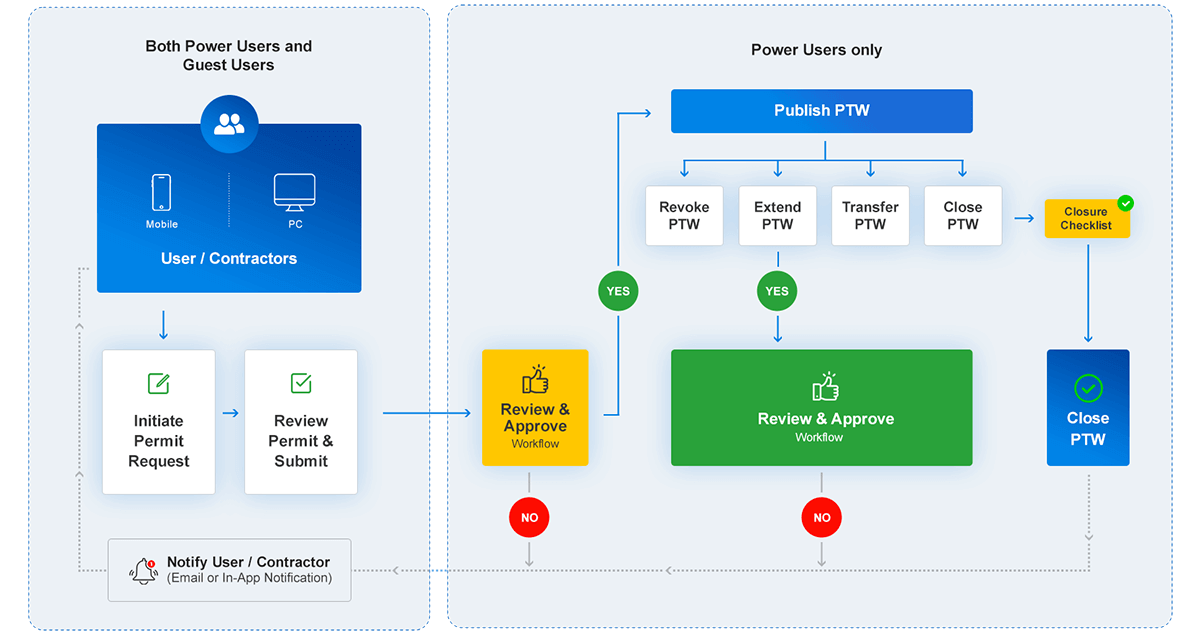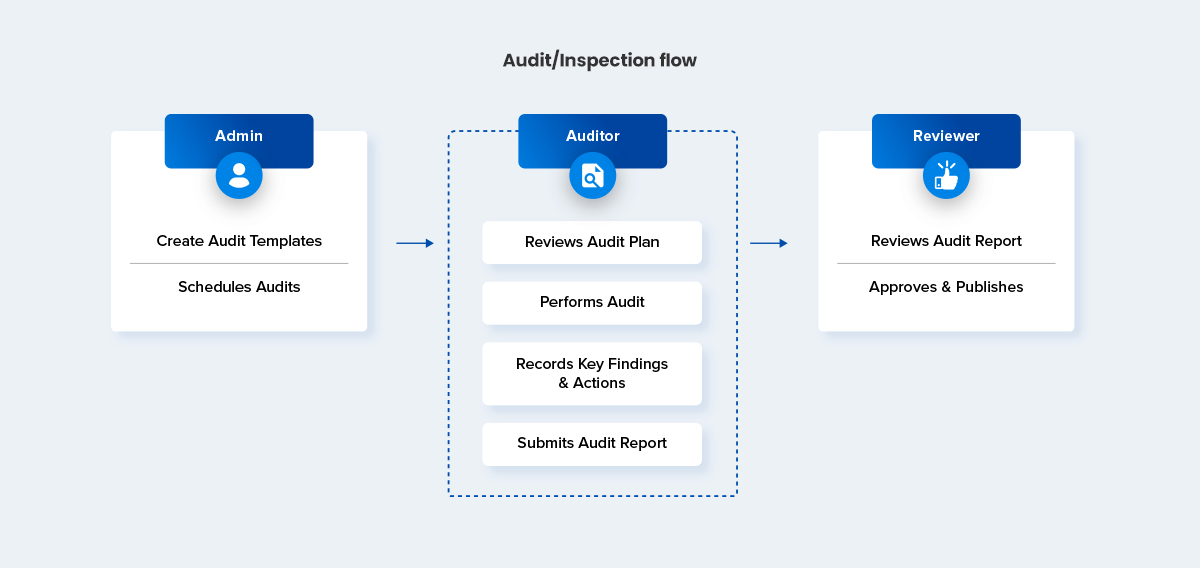Safety software built just for you.
Feature rich
Every feature you need to report, manage and analyze workplace safety.
Customizable
Safetymint Enterprise can be fully customized to suit your requirements.
Multi-lingual
Safetymint comes in 7 languages, plus the form fields can accept any language.
Free templates
The template library includes several inspection and work permit templates.
Checklist builder
Build any type of inspection checklist or permit to work forms easily.
Web and mobile
Access the software on web and mobile devices and also on offline mode.
Fast and flexible
Get started with Safetymint SaaS in 2 weeks with onboarding help from us.
Modern
Intuitive user experience and fast loading, compared to clunky enterprise software.
3rd party integration
Link with your favorite ERP or Analytic tools with our flexible REST API's.
Key Modules in Safetymint
Incident and Observation Management
Give the power of reporting any type of safety incidents, observations and near misses to every employee in your organization. Incident reporting can be done via web browser or mobile app – even if the user is offline. As an administrator to your account, you can configure the safety categories, add workflow and designate access rights to each user in the system. The incidents reported can go through a 5-step incident investigation process that covers the root cause analysis and corrective and preventive action (CAPA) to avoid the same incident in the future.

Key Benefits

Cloud-based software

Customizable dashboard

Third-party integrations

Alerts and notifications

HIRA registry

Customizable workflow

Unlimited sites and usage

Document management
Permit to Work Management
Safetymint Permit to Work system allows you to fully digitize your traditional permit to work process. Be it requesting a permit approval, revoking a permit, extending or closing, every task can be handled via the Safetymint web and mobile platform - saving you over 70% of time spent on paper or spreadsheet based processes. The user-friendly permit template builder allows you to easily digitize your existing permit forms. The customizable workflow can be set as sequential or parallel with 5 levels of approvals and escalation option.
Permit to Work Process Flow

Key Benefits

Cloud-based software

User-friendly checklist builder

Free permit templates

Alerts and notifications

Contractor management

Customizable workflow

Unlimited sites and usage

Document management
Audits & Inspection Management
Safetymint Audits and Inspection management module helps auditors and inspectors handle the entire process digitally, without any paper or spreadsheets. The powerful checklist builder helps you to build any type of safety audit or inspection checklists easily. The checklist builder also includes a wide range of response type to choose from, including rule based responses. The integrated workflow can be customized to set approvers and escalation. Site inspections can also be carried out using your mobile or tablet device even in offline mode.

Key Benefits

Cloud-based software

User-friendly checklist builder

Free inspection templates

Alerts and notifications

Mobile and tablet compatible

Customizable workflow

Unlimited sites and usage

Document management
Customers across regions and industries












Ready to upgrade your safety management?
All about Safety Management Software
It’s not surprising that digitization has brought a fundamental shift in how safety is managed in an organization. In this guide, we help you learn more about safety management software so that you can make an informed decision while moving away from traditional processes. Read on…
What is Safety Management Software?
Safety software is a vital tool in efficiently managing safety processes in your business. It helps you ensure that you meet all your safety requirements and comply with local laws. The software will help you ensure that your company follows the correct procedures and avoids any potential accidents or incidents.
Why Do You Need A Safety Software?
The use of safety software for safety management is
becoming more and more common. There are many reasons for
this, but the most important reason is that it makes
managing safety much easier and more efficient.
But a safety software is not just a tool to track health and
safety. It can also help you manage your company's overall
sustainability efforts. With the right safety software, you
can create a comprehensive safety management program to help
you meet legal compliance, prevent risk and
liability, and improve employee safety.
Here are some reasons why your organization needs a software to manage safety:

Improve Your Organization's Safety Without Spending a Lot of Time
Often, organizations question why they need to invest
in safety software. Well, the answer is simple: you
would, if you want to improve the efficiency and
effectiveness of your workplace.
The safety software solution is based on a set of
powerful modules which allow you to monitor and manage
the safety management process. It allows you to track,
measure, analyze and report on all the processes related
to occupational health & safety.
This means that you don't need to spend time on manual
record-keeping or other time-consuming tasks. It also
makes it easier for you to comply with regulatory
requirements and keep your employees safe at all times.

Develop a Safety-Oriented Culture
An EHS software can help you create a culture of collaboration and accountability. When the process is transparent and everyone is on the same page, it's easier to identify and address problems quickly. This type of transparency creates an environment where employees feel safe raising concerns about unsafe conditions because they know management is committed to resolving them quickly.

Analyze & Solve Safety Hazards at Its Roots
Another reason why we need an HSE software is that it can
help us improve our business by providing useful
information about our work environment and its impact on
employee health and safety. Also, it provides
information about hazards, risks and incidents which can
be used for improving our business processes to achieve
better results from the workers' safety perspective.
In addition to tracking incidents, near misses,
injuries, and other safety-related metrics, a safety
app can help you manage your training programs by
providing an easy way to share information about new
policies or training modules with employees. This keeps
everyone up-to-date on important company policies and
procedures.

Conduct Audits & Inspections Quickly
The compliance requirements have increased
significantly in recent years; hence, it has become
difficult for companies to maintain compliance with
various standards and regulations through manual
processes.
With the help of a Safety management software, you can
automate most of your existing manual processes and
reduce the time taken to complete audits and
inspections. The best safety software allows
organizations to easily create inspection checklists
that include all the necessary details about each area
that needs to be inspected — such as equipment
condition, safety equipment status, etc. This saves time
during an audit and allows the inspectors and auditors
to focus on the actual work without searching for
information.
Key Safety Management Software Features
Safety software is becoming more and more popular in the
modern workplace. From tracking employee safety to meeting
compliance standards, companies are finding that it can be
an excellent tool for improving productivity and efficiency.
Because the safety software market is so competitive, there
are many different options to choose from. And if you're not
careful, you might end up with software that doesn't do what
you need.
So what features should the best safety management software have? Let’s find out.

Mobile Access
The ability to access your data on the go is a must-have for any modern software. You should be able to use your safety software even when you're out of the office, so it's vital that it works from any device with an internet connection and can be accessed from anywhere and on any device. This gives employees more flexibility and increases productivity by allowing them to work anywhere at any time.

Data Security
Data security is one of the most essential features that you should look for in safety software. You need to look for robust security features that protect your data from unauthorized access, such as encryption capabilities and password protection. You should also make sure that the vendor has experience working with regulated industries so they can ensure that the software meets all applicable regulatory requirements.

Customizable Dashboards
A good safety software should allow users to customize their dashboards according to their needs, so they can create exactly what they want without having to rely on IT support or anyone else. You should be able to see all the key metrics on one screen so you can quickly identify problems in your operations. You should also be able to configure the dashboards to display your critical information.

Incident Reporting Capabilities
One of the common uses of a safety management system is
its ability to capture and record incidents.
But when you’re looking for a comprehensive safety
software, you should also look for advanced incident
management capabilities like the ability to use
pre-built workflows, automated incident reporting and
management, the type of data capture allowed as well as
simple-to-use analytics to explore in-depth about the
incidents and come up with preventive measures.

Integration with Other Systems
The best safety software allows you to seamlessly integrate and gather data from diverse sources, including spreadsheets and other applications. This allows data to flow freely and makes it easier for your team members to access the data they need. It also eliminates the double data entry into multiple systems and saves time and effort by eliminating manual tasks. So make sure to enquire about your safety software's integration options before investing.
Compliance Tracking
It's crucial for organizations to track their compliance with laws and regulations, such as OSHA, EPA, FDA and more. Compliance tracking allows organizations to review their safety records over time, identify areas where problems may exist and work with employees to improve compliance rates. This makes it easier for you to ensure compliance and avoid fines or penalties from regulators.

Auditing & Reporting Capabilities
The safety software should allow you to easily audit all aspects of your business, including safety training records, incident reports, corrective actions taken and more. In addition, it should also offer reporting tools and customizable checklists so that it's easy for internal teams to conduct audits, keep records, analyze and improve organizational safety.
Choosing the Best Safety Software - questions to ask
The decision to invest in a safety management software can
be a difficult one. There are so many factors to consider -
how it will fit into your existing infrastructure, what kind
of training you need, what the return on investment will be
and how it will help you achieve your goals.
To help you make an informed decision and avoid costly
mistakes, here are a few questions to ask before choosing
the best safety management software for your business:
- Is it a custom solution or an off-the-shelf product?
- How much time will be required to deploy the system?
- What kind of training do employees need to use the software effectively?
- What kind of compliance can it meet?
- Is it scalable? Can I add other modules and features as and when I need them?
- What kind of data can it collect?
- How often does the vendor update the software?
- What kind of support does the vendor provide after purchase?
- Will it integrate with other applications we use?
- What are the requirements for using this software? Does it need to be installed on my computer, or can I access it through a web browser?
- Do I have to pay anything extra if more people in my company want to use the software simultaneously?
- Is there a mobile version available?
- How easy is it to create reports? And does the software support different formats of reporting?
- What are the costs involved upfront and on an ongoing basis?
Use Cases of Safety Software across industries

Manufacturing
Manufacturing companies
have one of the most complex health and safety
management systems. They must follow strict regulations
for hazardous waste disposal, spills and chemical
storage and handling. And an safety software can reduce
the cost of compliance by tracking the processes and
ensuring everything meets the local, regional and global
regulations.
An safety management software also helps them track all
their processes and activities efficiently. This helps
them to improve their overall performance by eliminating
any kind of waste or redundancy.

Construction
The construction industry uses safety software to ensure that they are compliant with all regulations related to occupational health and safety. The safety management software also helps them manage their workflows efficiently so that they can meet deadlines without compromising on quality or safety standards.

Energy
Government agencies
heavily regulate energy sectors through various
regulations and standards like EPA, LDR and PCB.
To comply with the environmental protection regulations,
energy companies use safety management software to track
compliance with environmental regulations such as those
related to greenhouse gas emissions, air quality
monitoring, waste disposal, and much more.

Pharmaceuticals
The pharma industry is another sector where safety
software can help companies reduce their operational
costs by automating various processes like facility management,
inventory management and process automation.
Pharma companies must comply with FDA regulations to
ensure that all operations within their facilities
conform to good manufacturing practices (GMP). The
safety software helps these companies ensure that all
operations are conducted safely and efficiently by
providing information on compliance data from various
departments such as R&D, manufacturing and quality
assurance.

Utilities
The utilities sector includes power generation plants
where safety management software can collect data from
various sensors installed around these plants for
monitoring environmental conditions like temperature,
humidity, pressure, vibration, airflow, etc. This data
is then analyzed using advanced analytics tools like
machine learning algorithms to detect anomalies that
could lead to disasters like explosions or fires at
these facilities.
Utilities also use safety management software for
managing environmental compliance issues such as
wastewater treatment systems, permit applications for
wastewater discharge permits, and stormwater permit
applications, among many others.

Mining
Mining is one of the most hazardous industries and needs to be managed carefully. The safety software helps in managing safety aspects of mining operations by enabling companies to track and measure compliance with occupational health and safety practices. It also helps mine owners and operators to manage labor costs, improve productivity and avoid fines from regulatory agencies like MSHA (Mine Safety and Health Administration) or OSHA.
Why Safetymint as your safety software:

Improved safety and compliance:
Safetymint helps companies monitor and manage safety on their job sites, ensuring that workers are following safety protocols and that the company is in compliance with industry regulations.

Enhanced communication and collaboration:
Safetymint provides tools for sharing safety information and data across teams, making it easier for workers, supervisors, and managers to collaborate on safety efforts.

Increased efficiency and productivity:
With Safetymint, companies can streamline their safety processes, reducing the time and effort required to monitor and manage safety on the job site. This can lead to increased efficiency and productivity, helping companies complete projects faster and more cost-effectively.
Better tracking and reporting:
Safetymint offers advanced tracking and reporting capabilities, allowing companies to collect data on safety incidents and near-misses, identify trends and patterns, and take corrective action as needed. This can help companies reduce the frequency and severity of safety incidents, improving overall safety on the job site.

Reduced costs and liabilities:
By using Safetymint, companies can reduce their exposure to safety risks and liabilities, which can help to lower their insurance costs and protect against costly lawsuits and fines. This can ultimately save companies money and help them stay competitive in the market.
